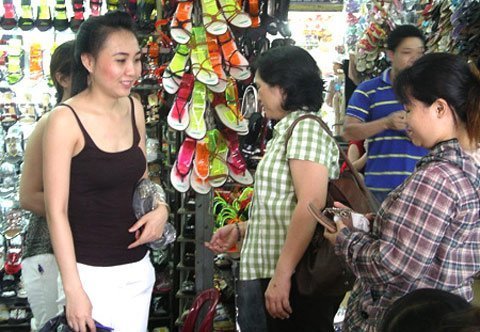VietNamNet Bridge – As Chinese goods have been “boycotted” by Vietnamese
consumers for fear about the products’ safety, Thai goods have been penetrating
the Vietnamese market.

Thai replace Chinese to dominate Vietnamese market
Analysts say the imports from Thailand rank the second in the market in terms of
quantities, after China. However, Thai goods are dominant in some market
segments, including electronics and refrigeration machines, such as TV, cookers
and hair dryers, holding 70 percent of the market share.
Thai cosmetics have also been more favored than Chinese. A representative from
the company specializing in distributing cosmetics in HCM City said that
Thailand is the biggest supplier of popular medium priced cosmetic products.
Thai cosmetics now account for 80 percent of the products available at the
kiosks at the big wholesale markets in HCM City.
Thai food, fruits, clothes and footwear have also been favored by Vietnamese
consumers. The imported fruits from Thailand, including rambutan, durian, mango
or oranges have always been selling very well. Sometimes they are sold better
than domestic products, even though they are more expensive.
Lan, the owner of a fruit shop at Van Thanh market, said that 40 percent of the
fruits available at her shop are imports, mostly from Thailand, while the other
60 percent from domestic orchards. She also said that consumers like Thai
rambutan and durian, even though the products are 30-50 percent more expensive.
Thai goods wave would come after wave of Chinese goods?
Vietnamese consumers now turn their back to Chinese goods after local newspapers
rang the alarm bell over the unsafe products. However, observers said,
Vietnamese consumers do not use Vietnamese, but use Thai instead.
That explains why Thai products have been available at traditional markets and
supermarkets, small shops or specific supermarkets.
The owner of a pottery and glassware shop at Kim Bien Shop said that Thai
products are 20-30 percent more expensive than Chinese, however, 90 percent of
the products available here are from Thailand.
“People are afraid of Chinese goods, and they tend to buy Thai goods,” she said.
An Dong Market, which has been well-known as the big market distributing Chinese
goods, now is also selling Thai goods. Some merchants have shifted to trade Thai
goods of different kinds, from clothes, footwear and handbags.
An executive of Big C, one of the biggest retail chains in Vietnam, has also
noted that Vietnamese consumers began using Thai goods before the 2009 Tet, and
that the supermarket has also shifted to distribute Thai instead of Chinese
products.
Analysts all have agreed that Thai products would replace Chinese on the
Vietnamese market, for many reasons. Vietnamese consumers prefer Thai to
Chinese. Meanwhile, merchants find it easy to place orders with Thai suppliers.
Nguyen Thi Ngoc Tuyen, the owner of a shop specializing in children’s clothes in
district 4, said that she just contact Thai suppliers via Internet to place
orders.
“If your orders are big, you would have to wait 10-15 days to get deliveries,”
she said.
However, most of the merchants in HCM City follow another way to import Thai
products. Since it’s costly to import products via official channels, the
merchants cross the border to Thailand to collect goods themselves, which helps
them save money.
Source: Dat Viet
- © Copyright of Vietnamnet Global.
- Tel: 024 3772 7988 Fax: (024) 37722734
- Email: evnn@vietnamnet.vn